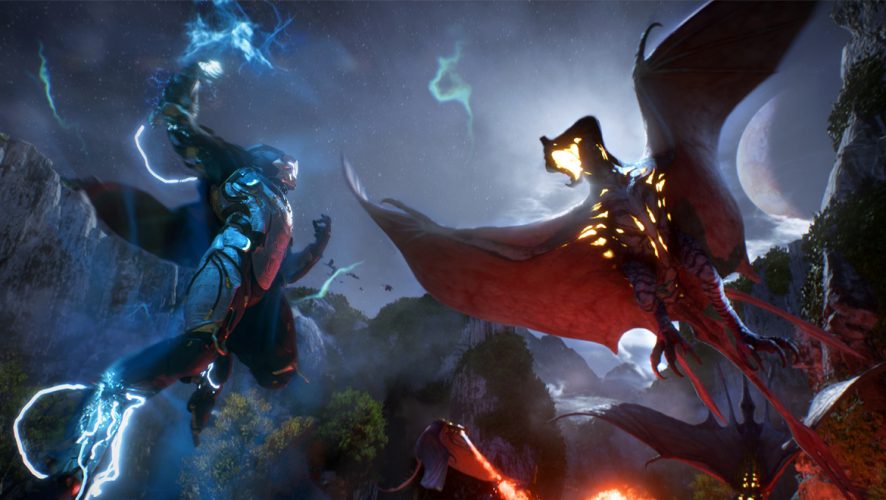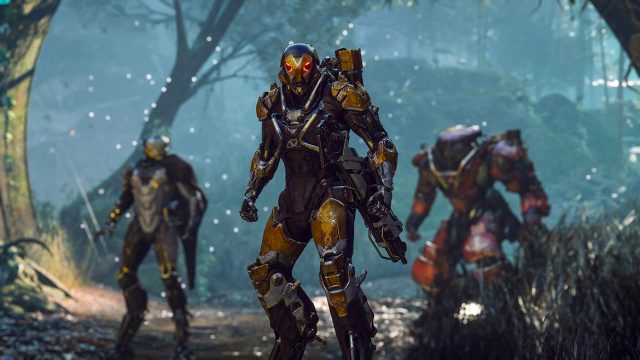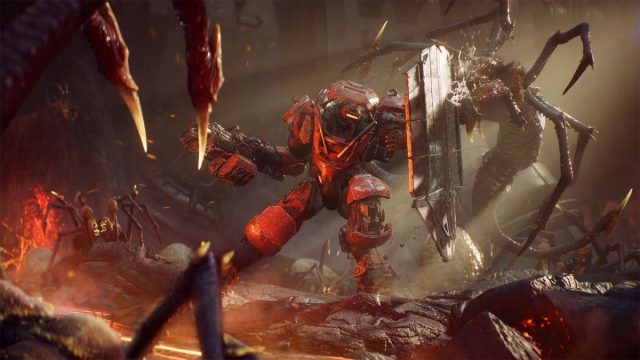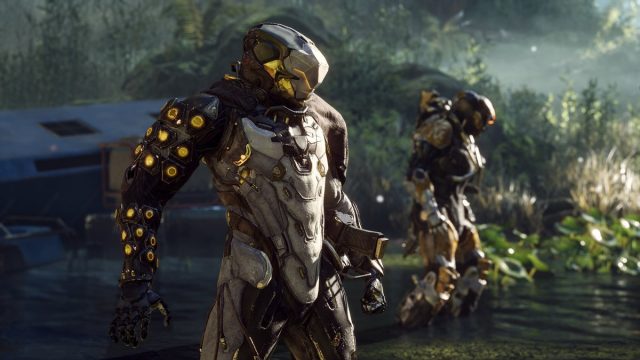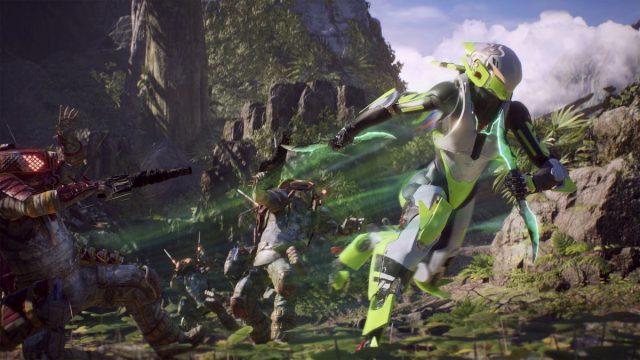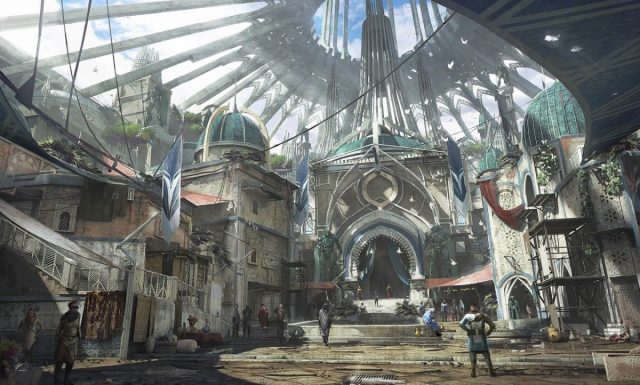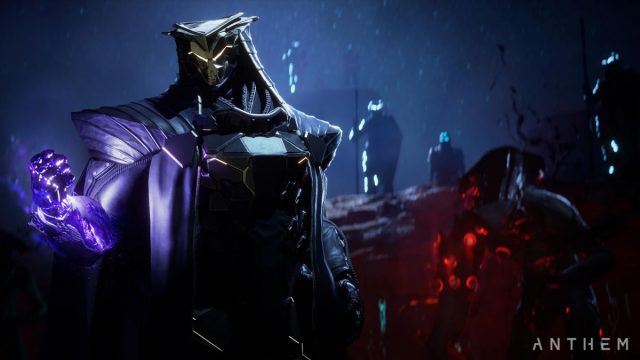“Iron Man Simulator”.
This phrase is often used to describe the gameplay of Anthem. The developers at BioWare have also said numerous times that superheroes were a major inspiration behind Anthem’s design.
It’s fitting, then, to use something from the first Iron Man film to illustrate how we feel about Anthem. Fairly early on the movie, there is a scene where Tony Stark suits up in the Iron Man Mark 2 prototype armour for the first time.
Against his better judgment, Stark decides to take the armour for a test flight. When Jarvis advises Stark against it, he admonishes Jarvis with the following line:
“Sometimes you gotta run before you can walk.”
That line perfectly describes the Anthem experience.
The central concept of Anthem is the act of flying around in a customizable armoured suit, in a lush, beautifully-rendered world, while raining death and destruction down upon your enemies.
Anthem absolutely NAILS this part. But unfortunately, it gets just about everything else wrong.
It’s very telling that Anthem is some of the most fun we have had in recent times… but only for about half the time. For starters, never has a AAA game done one thing so incredibly well, yet at the same time, fall so far off the mark in almost every other ways. But for all of Anthem’s brilliant, high-flying action, there are a ton of fundamental issues that bring the game crashing back down to the ground.
Let us be clear about this. Anthem (so far) has its moments and there’s plenty to enjoy in combat. But no amount of love can allow one to overlook the staggering amount of problems that it launched with.
Let’s talk about the good part first. The core moment-to-moment gameplay loop, specifically with regards to combat, is simply phenomenal. The combination of mobility and destructive power at your fingertips is quite unlike anything players would probably have ever experienced in a video game. To draw a comparison, Warframe probably comes the closest. Combat is fluid, exciting, and unrelenting in its intensity – as long as players aren’t trying to tackle a difficulty level that was way beyond their current capability, one easily feels like a superhero.
The player’s Javelin is powerful enough to take on multiple enemies at a time without too much trouble, but still sufficiently vulnerable that they can pose a real threat if one isn’t careful. Having previously talked about how Anthem was shaping up to be a much better power fantasy than Destiny, we can now say for certain that BioWare has successfully achieved that aim.
That sense of satisfaction you get at the end of a pitched battle cannot be understated, because the game truly makes you feel like a badass. Even after spending about 80 hours with Anthem, it’s easy to still get that same adrenaline rush whenever combat is engaged, and it’s not something that’s going away anytime soon.
Outside of combat is where things start to unravel. Anthem is plagued by a huge list of technical issues and questionable design decisions. While technical problems can vary from person to person, especially on PC, there are some design choices that players should really take issue with.
First on the list, and you knew this was coming: loading screens. There are far too many of them, and they take way too long in most cases. They are jarring, immersion-breaking, and have no excuse being in Anthem when we’ve seen plenty of other large open-world games offer seamless experiences without loading screens.
But as aggravating as they are, the loading screens are only a symptom of our biggest issue with Anthem: There is just too much downtime in between all the action (AKA the good part).
Load times aside, the multi-layered menus are a chore to navigate, and inventory management is slow, clunky, and badly executed. This is a loot game, and the process of going through your loot should be rewarding, but it feels punishing instead. Like many other action-RPGs that have come before, Anthem has a “Junk” feature. You can move unwanted items into the Junk, which allows you to salvage all of them at the same time. Sounds useful in theory.
However, for some unfathomable reason, it takes just as long to move an item into the Junk as it takes to actually salvage it, which completely defeats the purpose of this feature, because you end up taking even longer to accomplish what should have been a simple task.
It’s things like this that really hurt the experience, and make Anthem feel half-baked and incomplete. Most egregiously, the loot system (arguably the most important feature outside of combat) currently does not feel rewarding, in more ways than one.
Anthem supposedly promises more loot drops when played at higher difficulties, but this does not appear to be the case right now. Even if it were, difficulties from Grandmaster 2 and up are poorly balanced, and take way too much investment for only marginally better rewards, if at all.
On top of that, even after you’ve obtained a Masterwork or Legendary item, there is a good chance that the randomly-rolled inscriptions on it do not work, or do not fit the item itself. I’ve gotten multiple items with useless stats, such as Autocannons (a heavy weapon only usable by the Colossus Javelin) with bonuses to Pistol damage, when the Colossus can’t even use Pistols. Completing a Legendary Contract or Stronghold on Grandmaster difficulty, only to receive a reward like that for your effort can be really disheartening. Here’s hoping BioWare is paying attention, because this is simply disrespectful of the player’s time and needs to be addressed as soon as possible.
While we’re on the subject of time-wasting design, much has been said about walking/running around Fort Tarsis outside of your Javelin. It is excruciatingly slow. Your walking/running speed has supposedly been sped up since the demo, but one really can’t see any significant improvement at all. It should really be at least 2-3 times faster than it currently is to be considered acceptable.
This leads to another point about Fort Tarsis in general: Much like the Normandy in the Mass Effect trilogy, it’s supposed to be the central hub of the game world, yet it just feels so disconnected. It almost feels like the place belongs in another game entirely, and not a good one at that.
Nothing you do in Fort Tarsis is of any real consequence, aside from a couple minor bits of window dressing here and there. (Oh yay my fountain’s fixed!) Other than a handful of crucial conversations and cutscenes that play out here, the only other thing in Fort Tarsis that matters is picking up side quests and story missions.
Sure, you can have some mundane conversations with NPCs to earn some reputation with the 3 in-game factions, but these interactions are pretty hit-and-miss, and basically have no effect on the story whatsoever. More noticeably, there are 2 vendor NPCs that sell vanity and crafting items, but it’s faster to just bypass them by going into your menu and accessing the store directly. So why even have them around, then?
You’ll find yourself asking questions like these pretty often while playing Anthem. For instance, why even bother having dialogue options? I’m well aware that they are a BioWare hallmark, but the way it’s implemented into Anthem simply feels redundant. There are no meaningful choices here, and the story plays out the same way regardless of your decisions. It’s almost as if they felt a need to tack on these meaningless dialogue options just because people expect to see them in a BioWare game.
Let’s be real about this. Story elements in looter-shooters have always taken a back seat to the gameplay, and while players will appreciate that BioWare does attempt to try something different here, the final product just ends up pleasing nobody. Longtime BioWare fans, who care about story and character development would not appreciate what is essentially a half-assed effort, while those who don’t care will just skip everything to get to the gameplay as quickly as they can anyway.
What they should have done is deliver a more conventional narrative through scripted cutscenes, like in the first couple of story missions. Sure, it wouldn’t feel like a BioWare game then, but it would at least save us from the experience of trudging around Fort Tarsis as if we were stuck in tar.
Ultimately, Anthem is a live-service game, and if we’ve learnt anything from other live-service titles, it’s that the launch period is always rocky. Anthem is obviously no exception to that, and in fact “rocky” might be quite an understatement in this case. If anything, it’s quite frustrating that BioWare doesn’t seem to have learnt any lessons from the troubled launches of other similar titles. We have to remember that a game like Anthem doesn’t just exist in a vacuum. It’s competing against the likes of The Division and Destiny, games that have weathered their launch and are already firmly entrenched in the looter-shooter genre.
The long-term survival of Anthem will hinge upon how effectively BioWare is able to address the numerous complaints with the game so far. And considering how fundamental some of these issues are, at this point it’s hard to tell if even that will be enough to turn things around. To their credit, BioWare has been rolling out regular updates since launch that have improved things somewhat, however it remains to be seen if they can keep up the pace. As it is, Anthem is essentially an Early Access game, albeit one that you pay full price for.
From a consumer standpoint, this is obviously not acceptable and rubs many people the wrong way, and is clearly a major contributor to all the negativity currently surrounding the game.
All the negativity aside, there is plenty of potential in Anthem. The core experience is great, and it makes us crave more of it. We want to believe that Anthem will transform over time into that incredible game that was promised – the game that fans deserve.
The thing is, we have no idea just how long that will take, or if it is even possible. Assuming it is, we might have to wait 6 months to a year or more. As a gamer, that’s a very long time, and as such, we cannot in good conscience recommend that you go out and buy Anthem right now. Many gamers had lofty expectations for Anthem, and we totally understand how the current state of the game can be really disappointing for most people. If anything about Anthem interests you at all, take a wait-and-see approach on how the game evolves over the next few months, before you decide to take the plunge.
In spite of all it’s problems, we fully intend to revisit Anthem at a later date, if and when it has been improved upon. Hopefully, that will be sooner than later, and we remain excited to see what the future holds for this game.
GEEK REVIEW SCORE
Summary
BioWare’s first foray into the looter-shooter genre absolutely nails high-flying action, but drops the ball in all other aspects. A disappointment at launch, Anthem nevertheless contains plenty of untapped potential that will hopefully survive being buried under a tidal wave of negativity. BioWare sorely needs to turn things around for this game, but whether or not they will succeed remains to be seen.
Overall
6.8/10-
Gameplay - 7/10
7/10
-
Story - 6/10
6/10
-
Presentation - 8/10
8/10
-
Value - 6/10
6/10
User Review
( votes)Brian loves video games, gadgets, and comic books – in other words, all things geeky. Obsessed with lifting things up and putting them down repeatedly, he also loves ice cream, putting things together, and the occasional good book.

